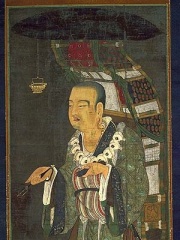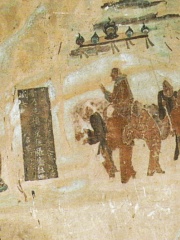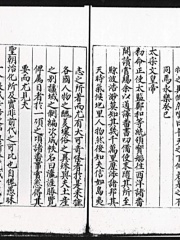




The Most Famous
EXPLORERS from China
Top 6
The following people are considered by Pantheon to be the most legendary Chinese Explorers of all time. This list of famous Chinese Explorers is sorted by HPI (Historical Popularity Index), a metric that aggregates information on a biography's online popularity.

1. Zheng He (1387 - 1433)
With an HPI of 84.21, Zheng He is the most famous Chinese Explorer. His biography has been translated into 140 different languages on wikipedia.
Zheng He (also romanized Cheng Ho; 1371–1433/1435) was a Chinese eunuch, admiral and diplomat from the early Ming dynasty, who is often regarded as the greatest admiral in Chinese history. Born into a Muslim family as Ma He, he later adopted the surname Zheng conferred onto him by the Yongle Emperor (r. 1402–1424). Between 1405 and 1433, Zheng commanded seven treasure voyages across Asia under the commission of the Yongle Emperor and the succeeding Xuande Emperor (r. 1425–1435). According to legend, Zheng's largest ships were almost twice as long as any wooden ship ever recorded, and carried hundreds of sailors on four decks. As emphasised by Tansen Sen, the powerful Ming navy brought a new militaristic presence to the Indian Ocean. It also encouraged state-controlled trade networks extending from China all the way to the Swahili coast of Africa. A favorite of the Yongle Emperor, whom Zheng assisted in the Jingnan campaign that overthrew the previous Jianwen Emperor in 1402, Zheng He rose to the top of the Ming imperial hierarchy and served as commander of the southern capital Nanjing.

2. Xuanzang (602 - 664)
With an HPI of 78.93, Xuanzang is the 2nd most famous Chinese Explorer. His biography has been translated into 65 different languages.
Xuanzang (Chinese: 玄奘; Wade–Giles: Hsüen Tsang; [ɕɥɛ̌n.tsâŋ]; 6 April 602 – 5 February 664), born Chen Hui or Chen Yi (陳褘 / 陳禕), also known by his Sanskrit Dharma name Mokṣadeva, was a 7th-century Chinese Buddhist monk, scholar, traveller, and translator. He is known for the epoch-making contributions to Chinese Buddhism, the travelogue of his journey to the Indian subcontinent in 629–645, his efforts to bring at least 657 Indian texts to China, and his translations of some of these texts. He was only able to translate 75 distinct sections of a total of 1,335 chapters, but his translations included some of the most important Mahayana scriptures. Xuanzang was born on 6 April 602 in Chenliu, near present-day Luoyang, in Henan province of China. As a boy, he took to reading religious books, and studying the ideas therein with his father. Like his elder brother, he became a student of Buddhist studies at Jingtu monastery. Xuanzang was ordained as a śrāmaṇera (novice monk) at the age of thirteen. Due to the political and social unrest caused by the fall of the Sui dynasty, he went with his brother 300 miles south to Chengdu in the current-day province of Sichuan, where he was ordained as a bhikṣu (full monk) at the age of twenty, studying Buddhist texts and practices at the monastery. He later travelled throughout China in search of sacred books of Buddhism. At length, he came to Chang'an, then under the peaceful rule of Emperor Taizong of Tang, where Xuanzang developed the desire to visit India. He knew about Faxian's visit to India and, like him, was concerned about the incomplete and misinterpreted nature of the Buddhist texts that had reached China. He was also concerned about the competing Buddhist theories in variant Chinese translations. He sought original untranslated Sanskrit texts from India to help resolve some of these issues. At age 27, he began his seventeen-year overland journey to India. He defied his nation's ban on travel abroad, making his way through central Asian cities such as Khotan to India. He visited, among other places, the famed Nalanda University in modern day Bihar, India, where he studied with the monk Śīlabhadra. He departed from India with numerous Sanskrit texts on a caravan of twenty packhorses. His return was welcomed by Emperor Taizong in China, who encouraged him to write a travelogue. This Chinese travelogue, titled the Records of the Western Regions, is a notable source about Xuanzang, and also for scholarship on 7th-century India and Central Asia. His travelogue is a mix of the implausible, the hearsay and a firsthand account. Selections from it are used, and disputed, as a terminus ante quem of 645 for events, names and texts he mentions. His text in turn provided the inspiration for the novel Journey to the West written by Wu Cheng'en during the Ming dynasty, around nine centuries after Xuanzang's death.

3. Zhang Qian (200 BC - 114 BC)
With an HPI of 71.94, Zhang Qian is the 3rd most famous Chinese Explorer. His biography has been translated into 40 different languages.
Zhang Qian (Chinese: 張騫; died c. 114 BC) was a Chinese diplomat, explorer, and politician who served as an imperial envoy to the world outside of China in the late 2nd century BC during the Western Han dynasty. He was one of the first official diplomats to bring back valuable information about Central Asia, including the Greco-Bactrian remains of the Macedonian Empire as well as the Parthian Empire, to the Han dynasty imperial court, then ruled by Emperor Wu of Han. He played an important pioneering role for the future Chinese conquest of lands west of Xinjiang, including swaths of Central Asia and even lands south of the Hindu Kush (see Protectorate of the Western Regions). This trip created the Silk Road that marked the beginning of globalization between the countries in the east and west. Zhang Qian's travel was commissioned by Emperor Wu with the major goal of initiating transcontinental trade in the Silk Road, as well as create political protectorates by securing allies. His missions opened trade routes between East and West and exposed different products and kingdoms to each other through trade. Zhang's accounts were compiled by Sima Qian in the 1st century BC. The Central Asian parts of the Silk Road routes were expanded around 114 BC largely through the missions of and exploration by Zhang Qian. Today, Zhang is considered a Chinese national hero and revered for the key role he played in opening China and the countries of the known world to the wider opportunity of commercial trade and global alliances.

4. Xu Fu (b. 255 BC)
With an HPI of 69.28, Xu Fu is the 4th most famous Chinese Explorer. His biography has been translated into 23 different languages.
Xu Fu (Hsu Fu; Chinese: 徐福 or 徐巿; pinyin: Xú Fú; Wade–Giles: Hsu2 Fu2; Japanese: 徐福 Jofuku or 徐巿 Jofutsu; Korean: 서복 Seo Bok or 서불 Seo Bul) was a Chinese alchemist and explorer. He was born in 255 BC in Qi, an ancient Chinese state, and disappeared at sea in 210 BC. He served as a court sorcerer in Qin dynasty China. Later, he was sent by Qin Shi Huang to the eastern seas twice to look for the elixir of life. His two journeys occurred between 219 BC and 210 BC. It was believed that the fleet included 60 barques with soldiers, ship crewmen, and 3,000 boys and 3,000 girls, and craftsmen of different fields. After he embarked on a second mission in 210 BC, he never returned.

5. Gan Ying (b. 100)
With an HPI of 65.28, Gan Ying is the 5th most famous Chinese Explorer. His biography has been translated into 27 different languages.
Gan Ying (Chinese: 甘英; pinyin: Gān Yīng; fl. 97 CE) was a Chinese diplomat, explorer, and military official who was sent on a mission to the Roman Empire to find out more about it in 97 CE by the Chinese military general Ban Chao. Gan Ying did not reach Rome, only traveling to as far as the "western sea" which could refer to either the eastern coast of the Mediterranean Sea, the Black Sea, or the Parthian coast of the Persian Gulf. From there he could have followed the Euphrates north to the Roman border in Syria in a few weeks, but he did not know this and instead he planned to sail around Arabia to Roman Egypt, which would have taken 3 months. Becoming discouraged by local sailors' stories of bad weather, he gave up and went home.

6. Ma Huan (1380 - 1460)
With an HPI of 61.74, Ma Huan is the 6th most famous Chinese Explorer. His biography has been translated into 20 different languages.
Ma Huan (simplified Chinese: 马欢; traditional Chinese: 馬歡; pinyin: Mǎ Huān, Xiao'erjing: ﻣَﺎ ﺧُﻮًا) (c. 1380–1460), courtesy name Zongdao (Chinese: 宗道; pinyin: Zōngdào), pen name Mountain-woodcutter (會稽山樵), was a Chinese explorer, translator, and travel writer who accompanied Admiral Zheng He on three of his seven expeditions to the Western Oceans. Ma was a Muslim and was born in Zhejiang's Kuaiji Commandery, an area within the modern borders of Shaoxing. He knew several Classical Chinese and Buddhist texts. He learned Arabic to be able to translate.
People
Pantheon has 6 people classified as Chinese explorers born between 255 BC and 1387. Of these 6, none of them are still alive today. The most famous deceased Chinese explorers include Zheng He, Xuanzang, and Zhang Qian.

